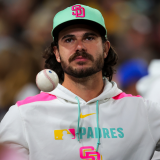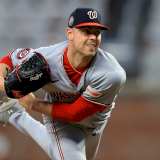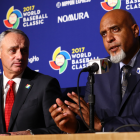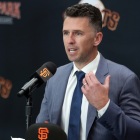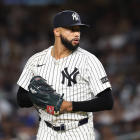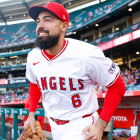Big Deal: Veterans thrilled, Red Sox hailed, Dodgers criticized (by some, anyway)
The quarter-billion deal drew some strong reactions around the league, particularly for the spend-happy Dodgers.
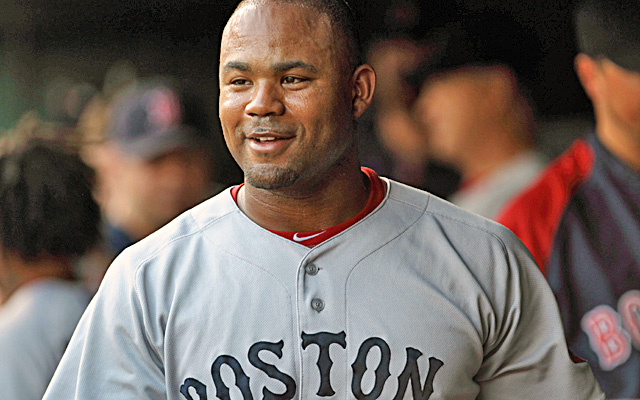 |
| Carl Crawford never really lived up to expectations in Boston. (Getty Images) |
One of the craziest, wildest and costliest (at least for one team involved) trades just went down, and many folks around baseball were left either admiring the sheer gall of the team that spent a quarter of a billion dollars (and about half of that on contracts that could only generously be called bad contracts), or wondering about the sheer craziness of it. Or maybe they were simply scratching their heads over the enormity of a trade in a month that’s known more for acquisitions of a more complementary nature.
Late August trades usually produce a back-of-the-rotation starter, a spare reliever or bench player, not two players signed to nine-figure deals (Adrian Gonzalez and Carl Crawford) and another who was twice a World Series hero (Josh Beckett).
| More on Red Sox-Dodgers deal |
| Analysis |
 |
| Related links |
|
| More MLB coverage |
|
When it was finished, you could imagine the principals on both teams celebrating. You could see the exuberant new Dodgers group fronted by Magic Johnson, the sunniest superstar in sports history, going nuts in the California sun. One observer said there were high fives and hugs all around in the aftermath of the July 31 trade that netted the new Dodgers group outfielder Shane Victorino, whose Dodgers future surely is limited to weeks now that Crawford and his $100-million nut have been imported.
Meantime, you could easily imagine Messers. John Henry, Tom Werner and Larry Lucchino enjoying a more low-key celebration in some blue-blood Back Bay club (no chicken and beer for this threesome). Having just ridded themselves of the worst contract in Red Sox history (Crawford’s), a growing thorn even if they wouldn’t admit it (Beckett’s overbearing presence among an impressionable underachieving younger rotation), and received two very nice pitching prospects in the process.
Everyone understood why the Red Sox, suffering through their unluckiest season in years, hit the reset button. But several baseball executives, who are only getting accustomed to the ways of the new Dodgers ownership group, were having trouble coming to grips with the calculation that led the Dodgers to take $130-million in bad deals (and surrender the pair of righthanded prospects) just for the privilege of one fair superstar deal, the Adrian Gonzalez contract. “Insane,’’ one rival National League executive called the Dodgers’ end of the trade.
You’ll excuse competing execs for hyperbole attached to this outsized deal, as they struggle to come to grips with what just went down. The deal -- which sent Gonzalez, Beckett, Crawford and feisty little utilityman Nick Punto west to the Dodgers for underachieving first baseman James Loney plus pitching prospects Rubby (pronounced Ruby) De La Rosa and Allen Webster, outfield prospect Jerry Sands and infield prospect Ivan De Jesus Jr. – was shocking from both ends.
No one has ever witnessed spending like the Dodgers in baseball (it’s like a mid-‘80s Steinbrenner on steroids, if you’ll pardon the analogy). And rarely has anyone seen a financially healthy club like the Red Sox, with baseball’s second highest revenue, conduct a late-August fire sale on the fly.
Here’s a closer look at how this affects the main players.
The Dodgers
Dodgers people got the ball rolling, originally calling Red Sox president Larry Lucchino with one question in mind: would the Red Sox consider trading Gonzalez, the quiet hitting star whose recent occasional complaints about the soap-operatic nature of the Red Sox scene had begun to seep into the media. The $2.15 billion spent to buy the team by the new Dodges ownership team – officially the Guggenheim Partners – was only the beginning, as new president Stan Kasten insinuated when he told CBSports.com soon after the purchase of the team, “You think that’s (the new owners’) last $2 billion?’’
Kasten had been known as an overspending critic as president of the Atlanta Braves, but sources suggest the directive to spend is the brainchild of the money men above Kasten. The unusual strategy seems to be to improve the team, no matter the cost.
The Dodgers took the entire $38 million remaining on Hanley Ramirez’s contract at a time when Ramirez was batting .240 something over a year and a half period (that moves seems prescient today as Ramirez has unearthed his old enthusiasm and found his old stroke, with an RBI a game in L.A.) and put in a claim on Cliff Lee, which would have obligated them to $95 million through 2015 had the Phillies simply said “take him.’’
“This is what happened when you have other people’s money to spend,’’ one competing owner said about the Dodgers, referring to the group’s insurance monies, while at the same time admiring their aggression. About this trade, that very same exec said, “This makes them the favorite in the National League to get to the World Series.’’
Unquestionably, they are the new financial bully on the block. But in the case of Lee, the Dodgers failed to persuade the Phillies to give him up, despite offering to send players (presumably prospects) to Philly to make it happen. The Phillies wanted to keep their big trio of starting pitchers together, and may have had an aversion to selling such a sale to fans that regularly jam Citizens Bank Park. The Red Sox, exhausted by a year of heartache, had no such qualms.
The Red Sox
After Lucchino got the call from Dodgers people expressing interest in A-Gon, it seems Red Sox higher-ups quickly figured out their best play was to use the Dodgers, a team with lower revenues, as their new piggy back. Even with sending them about $12 million, the Red Sox will save upwards of $250 million with this deal.
De La Rosa and Webster give the Red Sox two strong arms (Boston’s old GM Theo Epstein tried hard to pry Webster from L.A. for Ryan Dempster, but the Dodgers wouldn’t do it). The key to this deal for them, though, is what baseball people call “financial flexibility.’’
Lucchino and his Red Sox management team, willing to consider anything in season dominated by injuries and firestorms, surely didn’t take to long to realize that the best thing they could extract from the Dodgers’ new largesse was the very cash they have used as a weapon. And they got plenty of spending loot here.
The question is for Boston now is: Where to begin? The free-agent market isn’t exactly stocked with stars, and one may question whether the two best players – Josh Hamilton and Zack Greinke – are right for Boston.
Then again, who knows? No one, except his old team the Rays, realized Crawford wasn’t a fit in Boston after he starred in the American League East against Boston for so long. The Red Sox aren’t going to hoard the cash, and they have no intention to rebuild, so look for them to be a big player this winter.
For now, the deal is being mostly cheered in Boston, where everyone is fan enough to realize the mega gift horse their team just received. As much fretting as there was over the team’s standing this year, there was much more worry about how the Crawford contract might handicap them for six years to come.
There’s no second guessing a trade they had to make. But the trick now for Boston will be in finding where to spending their newfound largesse. They could use an outfielder, a starting pitcher and maybe a first baseman and shortstop. But where will they get them?
The Players
Gonzalez, Beckett and Punto all looked thrilled on a Twitter picture posted on Punto’s account from the Dodgers’ plane, sent special by their new team. You could imagine, of course. This team is first class all the way.
You could also imagine Crawford smiling just as broadly down in Florida, where he was rehabbing after his elbow surgery. Part of the new Dodgers’ excitement could come from the thrill of joining a pennant race. But much of it may come from the wonder of going to a place that seems even greener (as in money). As unhappy as players were to represent old owner Frank McCourt, they are that happy to play for Magic’s team.
After Beckett quickly waived his no-trade rights (“he wanted to leave,’’ one Red sox official said), and so did Crawford, whose inclusion of the Dodgers on his no-trade list of only three teams was interesting, the Dodgers sent the same for the trio.
GM Ben Cherington’s public niceties regarding Beckett may have been partly PR, as even the staunchest Beckett supporter had to wonder whether he was hindering a rotation of kids that followed him around and seemingly had lost its way. He also wasn’t pitching especially well, as his 5-11 record and 5 ERA attest. Said one rival GM: “If Beckett isn’t Beckett, I think the Dodgers are still in trouble.’’
The excising of the Crawford deal is the biggest benefit to Boston here, as no one could have imagined anyone taking a player with $100 million to go who had just gone under the knife. The Tommy John surgery may still allow Crawford to be ready for the start of the 2013 season. But even if it does open the year in L.A., the Dodgers have to hope, like Ramirez, he finds his pre-2011 Floridian glory.
He’s still young enough to do it, and Southern California may be laid-back enough to allow Crawford’s true talents to surface. For all A-Gon’s recent concerns about the Boston fishbowl, there isn’t any doubt the one it most affected was Crawford. There was reasonable question as to whether he ever was going to play to his potential in Boston, so it’s only right the Red Sox found the one team willing to absorb what’s left of his $142-million, seven-year deal.
No one else would have done it. No one else could have even considered it.
Let’s not forget, though, the Dodgers’ Hanley move has worked wonders despite some doubters. And even without Crawford until next year, the Dodgers’ lineup looks stacked.
The days where Matt Kemp was considered mostly alone are long gone. A smiling A-Gon was on the way, perhaps the very one who made impossible PETCO Park seem hitter friendly only a few years ago. Gonzalez wasn’t bad in Boston, but he wasn’t the freakishly good hitter that terrorized National League pitching for seasons in San Diego.
If the Dodgers get that guy, they may steal their division – though the word “steal’’ is being used loosely here, as it came with a quarter-billion-dollar expenditure.



